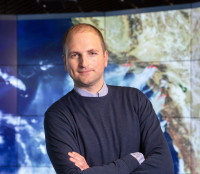Natural Catastrophes
Post-Doctoral Fellowships
Ireland
Underwater acoustic sensing for detection, early warning and increased risk awareness of storm surges with application to Ireland
Doctor Emiliano Renzi has always been fascinated by the sea and, today, is putting his training in engineering and mathematics to use in developing a pioneering technology to warn of approaching storm surges. Surprisingly, his tool for predicting extreme ocean waves depends on sound waves! The same weather phenomenon that kicks up such events at the water’s surface creates a fast-moving acoustic wave that travels ahead of the surge. Dr. Renzi plans to use underwater microphones to pick up this signal that a dangerous storm surge is coming. He is currently testing his mathematical models on real-life situations and expects his hydrophone detection system to be ready in a few years’ time. The advance warning this could provide will aid in evacuation decisions and allow threatened coastal residents to reach safety.
The Voice of a Storm Surge
Coastal flooding: how and why it happens
Interview by Olivier Monod, published on February 1, 2014 at 10:53
Is it possible to predict the vast, deadly waves known as "storm surges"? Emiliano Renzi, post-doctoral researcher at University College Dublin and AXA Research Fund beneficiary, is developing a more accurate detection system with a view to anticipating this dangerous phenomenon for coastal areas.
The risk of flooding due to exceptional waves depends on three factors: low pressure, strong winds and large tides.
afp.com/Fred Tanneau
What is a storm surge?
A storm surge is an unexpected sea-level rise. In coastal areas, this results in abnormally high waves, like those that swept people away in Biarritz, France, in January 2014. A surge usually occurs if three factors are combined: low pressure, strong winds and large tides.
The mechanism is as follows: low atmospheric pressure, due to a storm for instance, reduces the atmosphere's weight over the ocean. In places, the ocean swells by 10 to 20 centimeters. When this "dome" of sea reaches the coast, the combined effect of the tide and the violent winds sees waves stacking up against the shore. For local communities, the effect is the same as a small tsunami, but the physics involved with this phenomenon are very different. It occurs in winter in exposed coastal areas.
Researcher's background
Following his PhD in engineering sciences, Emiliano Renzi, a passionate sea enthusiast, set up an initial project on renewable marine energies, overseen by Professor Frédéric Dias. At the end of his contract, he presented his idea for storm surges to the AXA Research Fund and was awarded funding for two years. "I have always been fascinated by science and I am curious about how the world works. Today, I am using the tools of mathematics and physics to understand an element that I love, the sea." Follow him on Twitter.
Are these phenomena new developments? Are they linked to climate change?
With climate change, it is believed that these phenomena will become more frequent. They may also be displaced to other locations. During the last few years, storms and cyclones have been moving northwards. For a cyclone like Sandy to hit New York, this is quite a new development! We are more used to seeing this type of phenomenon further south. Storm surges are not created by climate change, but it is going to result in changes to them.
What new aspects will your model bring?
We are currently researching this phenomenon with large-scale models, which means that we are severely lacking in terms of any fine-grained analysis on a small scale. We are able to put the French Atlantic coast on orange alert, but we are not able to tell the people living in a particular town or city what the risk is for them. And yet these local effects are crucial. Today, the scale of storm surges can only be measured when they actually hit the coast, which is too late to warn the people living there.
What signals are you basing your local predictions on?
We are working to predict these phenomena thanks to their acoustic signature. When the wind violently stacks up masses of water, it creates acoustic waves in the water, just like when we talk on the phone thanks to the acoustic waves created by our voice and recorded by our microphone. We are therefore setting up hydrophones in the water to capture the acoustic waves. These waves travel very quickly through water, at a speed of 1.5 km per second, moving ahead of the mass of water.
However, there are lots of sources of noise in the ocean, from boats to whales. What do you do to identify the waves that are linked to storm surges?
There are lots of acoustic waves in the sea, but each source has its own frequency interval.
We are currently working on simple mathematical models with a calm sea and ideal conditions. These will enable us to learn what to look for and where.
Then, we will be working with more complex models developed based on data from natural environments, and we will be using artificial waves to put our findings to the test.
Another important part of our work is to raise public awareness on this issue. There are lots of scientific sites on storm surges, but there is no information for the general public. Recent events in Biarritz, France, prove that this approach is needed.
Find out more at http://www.lexpress.fr/actualite/societe/environnement/submersions-sur-les-cotes-pourquoi-et-comment-elles-arrivent_1316760.html#Ff34Kxt7muxJZRWD.99
To add or modify information on this page, please contact us at the following address: community.research@axa.com

Emiliano
RENZI
Institution
University College Dublin
Country
Ireland
Nationality
Italian
Related articles
Natural Catastrophes
Joint Research Initiative
Spain
Understanding Wildfire Risk: A Local-Scale Assessment Framework in Chile
Wildfire is a significant hazard across the globe, causing extensive economic, ecological and health impacts. While wildfires are common throughout... Read more

Marcos
RODRIGUES MIMBRERO

